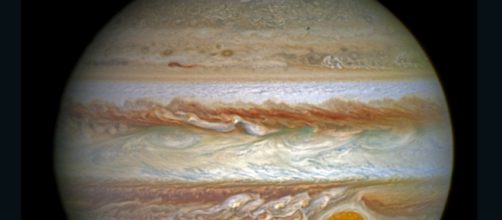The mission team behind Juno spoke about the first scientific results obtained by the device during time spent in the orbit of Jupiter. The scientists described the unusual behaviour of the gas belts of the gas giant and the first measurements of the planet's magnetic field. It turns out that it is 10 times higher than the strongest natural magnetic fields found on the Earth. The device transmitted the first full images of the aurora around the south pole, and also a series of new photos of the planet taken by JunoCam -- including the first pictures of Jupiter's rings "from within." Scientists discussed these findings at a press conference for #NASA.
LIVE NOW: First science results from my mission at #Jupiter. Got questions? Use #askNASA https://t.co/9dPnHB79vU pic.twitter.com/MxdMkNGeRx
— NASA's Juno Mission (@NASAJuno) May 25, 2017
Juno's main mission
Juno reached Jupiter on July 4, 2016. The main mission of the device was to analyze the magnetic field and atmosphere of the gas giant. In addition, scientists hoped to find out how Jupiter formed, and how hotspots were arranged, free from clouds, through which you can see the lower layers of the atmosphere of the planet.
Jupiter's Poles have a huge number of cyclones and anticyclones
In particular, Juno took the first-ever pictures of the Jupiter's poles. It turned out that the state of the atmosphere there is very different from the rest of the planet -- near the poles there are a huge number of cyclones and anticyclones the size of Earth.
Moreover, according to researchers, the north and south poles look unlike each other. Scientists are trying to find out the reasons for such complex, dynamic behavior.
Due to the microwave radiometer, Juno managed to look deep into the atmosphere of the planet. The data indicates that the equatorial cloud belt of Jupiter practically does not change up to depths of several kilometers. Belts located at higher latitudes with depth change their state.
#Jupiter sings: hear plasma wave signals from Jupiter’s ionosphere converted to sound: https://t.co/bDtEqfi03J
— NASA's Juno Mission (@NASAJuno) May 25, 2017
Jupiter has most powerful magnetic field
A whole new world: my first in-depth science results reveal a strikingly complex #Jupiter. Details: https://t.co/wVdMNaBKp1 pic.twitter.com/LXKr32KASp
— NASA's Juno Mission (@NASAJuno) May 25, 2017
The magnetometers made it possible to evaluate the induction of the planet's magnetic field.
Previously it was known that Jupiter is the owner of the most powerful magnetic field in the solar system, that, in particular, indicates the brightness of its auroras. The new data confirms this, and even exceeds the theoretical estimates. According to scientists, its induction reaches 7.76 gauss, which is more than 10 times higher than the strongest natural fields found on Earth.
Now the device is in an elongated orbit -- making one revolution around the planet every 53 days. According to the initial mission plan, in September 2016, the interplanetary station had to change the orbit and shorten the circulation period to two weeks. Because of the breakdown, this transition had been postponed several times, and in February it was completely cancelled. It will not affect the scientific mission of the device, however.


